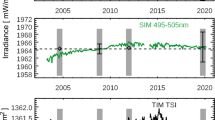Abstract
We have investigated long-term variations of solar brightness as a function of both time and solar latitude using eight years of ground-based photometric data in conjunction with space-based irradiance data. In particular, we have examined whether the combination of sunspot brightness deficits and facular brightness excesses is sufficient to explain the solar cycle irradiance variations. After correcting for the contribution from sunspots, we find that the irradiance data can be adequately explained by a model in which the remaining brightness variations are due entirely to facular contributions confined to the magnetically active latitudes. Thus we find no support for the hypothesis that there are convectively driven hot bands in the active latitudes, and our data show brightness variations that are well described by a facular contrast function.
Similar content being viewed by others
References
Allen, C. W.: 1976, Astrophysical Quantities, third edition, The Athlone Press, New York.
Chapman, G. A., Cookson, A. M., and Dobias, J. J.: 1996, J. Geophys. Res. 101, 13541.
de Toma, G, White, O. R., Chapman, G. A., Walton, S. R., Preminger, D. G., Cookson, A. M., and Harvey, K. L.: 2001, Astrophys. J. 549, L131.
Fontenla, J., White, O. R., Fox, P., A., Avrett, E. H., and Kurucz, R. L.: 1999, Astrophys. J. 518, 480.
Foukal, P. and Lean, J.: 1988a, Geophys. Res. Lett. 25, 4377.
Foukal, P. and Lean, J.: 1988b, Astrophys. J. 328, 347.
Fröhlich, C.: 2000, Space Sci. Rev. 94, 15.
Fröhlich, C. and Lean, J: 1998, Geophys. Res. Lett. 25, 4377.
Kuhn, J. R. and Stein, R. F.: 1996, Astrophys. J. 463, L117.
Kuhn, J. R., Libbrecht, K. G., and Dicke, R. H.: 1988, Science 24, 908.
Kuhn, J. R., Floyd, L., Fröhlich, C., and Pap, J. M.: 2000, Space Sci. Rev. 94, 169.
Lean, J. L.: 2000, Space Sci. Rev. 94, 39.
Lean, J. L., Cook, J., Marquette, W., and Johannesson, A.: 1998, Astrophys. J. 492, 390.
Preminger, D. G., Walton, S. R., and Chapman, G. A.: 2002, J. Geophys. Res., in press.
Solanki, S. K. and Unruh, Y. C.: 1998, Astron. Astrophys. 329, 747.
Spruit, H.: 2000, Space Sci. Rev. 94, 113.
Steinegger, M. Brandt, P. N., and Haupt, H. F.: 1996, Astron Astrophys. 310, 635.
Taylor, S. F., Varsík, J. R., Woodard, M. F., and Libbrecht, K. G.: 1998, Solar Phys. 178, 1.
Unruh, Y. C., Solanki, S. K., and Fligge, M.: 1999, Astron. Astrophys. 345, 635.
White, O. R. and Rottman, G. J.: 2000, Space Sci. Rev. 94, 93.
Author information
Authors and Affiliations
Rights and permissions
About this article
Cite this article
Woodard, M., Libbrecht, K. Spatial and temporal variations in the solar brightness. Sol Phys 212, 51–64 (2003). https://doi.org/10.1023/A:1022952206013
Issue Date:
DOI: https://doi.org/10.1023/A:1022952206013




